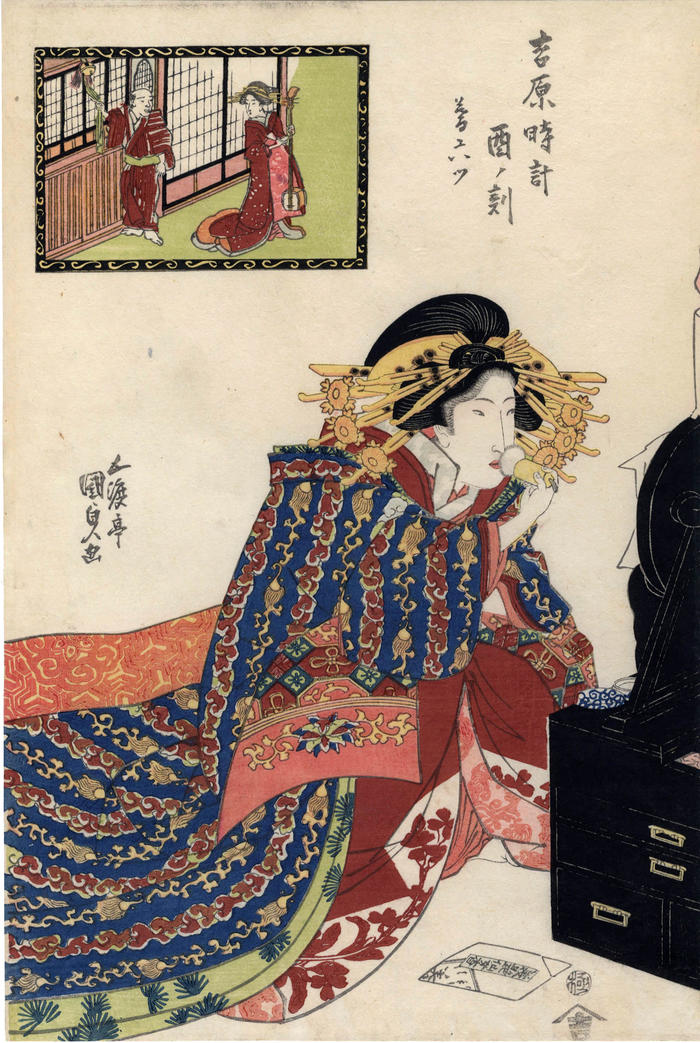Utagawa Kunisada (歌川国貞) / Toyokuni III (三代豊国) (artist 1786 – 01/12/1865)
The Hour of the Rooster, Sixth Hour of Twilight (Tori no koku, Kure muttsu) - 5 to 7 PM, from the series A Yoshiwara Clock (Yoshiwara tokei nihen - Mitate hakkei - 吉原時計 酉ノ刻 暮六ツ)
1823
10 in x 14.75 in (Overall dimensions) Japanese woodblock print
Signed: Gototei Kunisada ga
五渡亭国貞画
Publisher: Enomotoya Kichibei
(Marks 054 seal 01-053)
Censor's seal: kiwame
Museum of Fine Arts, Boston
Waseda University
Ritsumeikan University (B/W)
Google maps - Yoshiwara Shrine - one of the only signs of where this famous district was
Lyon Collection - another print from this series
The Albertina
Lyon Collection - another print underwritten by Bien Senjokō face powder
Nationaal Museum van Wereldculturen (Rijksmuseum Volkenkunde, Leiden) via Ritsumeikan University Scholten Japanese Art wrote of this print: "A lavishly attired courtesan powders her nose in front of a black lacquer kyodai (mirror stand), her voluminous uchikake spreading out behind her like an ornate carpet. A packet of Bien Senjoko [美艶仙女香] face powder is situated in the foreground in an early example of product placement. In the pictoral cartouche above we see a vignette of a young woman holding a shamisen while standing beside a man ringing a bell at the entrance to a teahouse or restaurant."
Elsewhere, Scholten had also written: "Her inner purple and rose colored underrobes [sic] have floral designs, and her perfectly coiffed hair is embellished with numerous gold lacquer hair ornaments. Kunisada focuses our attention on her ornate blue uchikake (formal coat) spreading out behind her like a carpet and decorated with a distinctive shima (striped) pattern with alternating bands of purple stylized clouds and gold karakusa (scrolling vines) linked with tassels that are suggestive of kakuremino (cloak of invisibility, a treasure of the Lucky Gods). This unusual pattern may have had a moment in circa 1820 as it is also found on two print designs by Keisai Eisen (1790-1848), the first worn by another courtesan similarly draped from her shoulders, and a slightly later print portraying a young wife contemplating a similar fabric for use as an obi (a more sensible use of an expensive material)."
****
It should be noted that in a lecture, 'The Poetics of Inscribed Kabuki Actor Prints', viewable on YouTube, by John T. Carpenter said that the three-string shamisen was "the most common instrument of the Yoshiwara brothels as well as kabuki and among geisha."
****
Sebastian Izzard noted, in speaking of a different series by Kunisada, that one of the prints in this set displays "...a packet of Bien Senjokō (Beautiful fairly maiden fragrance), a popular cosmetic whose brand name was based on the poetry name (haimyō) Rokō, of the Kabuki actor Segawa Kikunojō V (1802-32), one of Edo's leading contemporary onnagata, or players of female roles. It was manufactured by Sakemoto, a man who often used beauty and landscape prints to promote his products. Indeed, selling this kind of advertising was a common way for publishers, such as Azumaya to defray the expenses of producing prints."
****
A woman is kneeling before a lacquered mirror stand as she applies a cosmetic with a hand-brush. The season of the year may well be winter considering the number of layers of gorgeous robes the courtesan, an oiran, is wrapped in.
There are twelve prints in this set.
Illustrated: An Italian in Japan: Prints from the Edoardo Chiossone Collection, Museum of Art, Genoa.
Enomotoya Kichibei (榎本屋吉兵衛) (publisher)
beautiful woman picture (bijin-ga - 美人画) (genre)
mitate-e (見立て絵) (genre)
